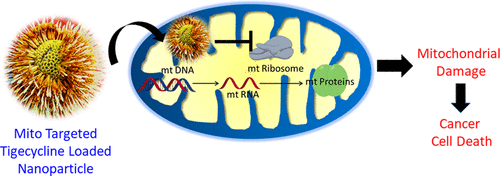当前位置:
X-MOL 学术
›
ACS Appl. Bio Mater.
›
论文详情
Our official English website, www.x-mol.net, welcomes your
feedback! (Note: you will need to create a separate account there.)
Nanoparticle-Mediated Routing of Antibiotics into Mitochondria in Cancer Cells
ACS Applied Bio Materials ( IF 4.6 ) Pub Date : 2021-08-11 , DOI: 10.1021/acsabm.1c00527 Aman Bajpai 1 , Nakshi Nayan Desai 2 , Shalini Pandey 1, 3 , Chinmayee Shukla 2 , Bhaskar Datta 1, 2 , Sudipta Basu 1
ACS Applied Bio Materials ( IF 4.6 ) Pub Date : 2021-08-11 , DOI: 10.1021/acsabm.1c00527 Aman Bajpai 1 , Nakshi Nayan Desai 2 , Shalini Pandey 1, 3 , Chinmayee Shukla 2 , Bhaskar Datta 1, 2 , Sudipta Basu 1
Affiliation

|
In recent years, antibiotics have emerged as alternative medicines in cancer therapy due to their capability of mitochondrial dysfunction in cancer cells. However, antibiotics render collateral damage in noncancerous cells by targeting mitochondrial transcription and translational machinery. To address this, herein, we have engineered three different mitochondria-targeted cationic antibiotic (tigecycline)-loaded nanoparticles from cholesterol conjugates. Dynamic light scattering and electron microscopy confirmed the spherical morphology and a less than 200 nm hydrodynamic diameter for these nanoparticles. The triphenylphosphine-coated tigecycline-loaded nanoparticle (Mito-TPP-Tig-NP) was shown to be homed into the mitochondria of A549 lung cancer cells compared to the other cationic nanoparticles. These Mito-TPP-Tig-NPs indeed triggered mitochondrial morphology damage and generation of reactive oxygen species (ROS). All the mitochondria-targeted tigecycline-loaded nanoparticles showed improved cancer cell killing ability in A549 and HeLa cervical cancer cells compared to free tigecycline. Moreover, Mito-TPP-Tig-NPs showed much less toxicity toward noncancerous human embryonic kidney cells (HEK293) compared to free tigecycline. These antibiotic-loaded mitochondria-targeted nanoparticles can open up an avenue toward anticancer therapy.
中文翻译:

纳米粒子介导的抗生素进入癌细胞线粒体的路径
近年来,抗生素由于其在癌细胞中线粒体功能障碍的能力而成为癌症治疗的替代药物。然而,抗生素通过靶向线粒体转录和翻译机制对非癌细胞造成附带损害。为了解决这个问题,在此,我们从胆固醇缀合物中设计了三种不同的线粒体靶向阳离子抗生素(替加环素)纳米颗粒。动态光散射和电子显微镜证实了这些纳米粒子的球形形态和小于 200 nm 的流体动力学直径。与其他阳离子纳米颗粒相比,三苯基膦包覆的替加环素纳米颗粒 (Mito-TPP-Tig-NP) 被证明可以归巢到 A549 肺癌细胞的线粒体中。这些 Mito-TPP-Tig-NPs 确实引发了线粒体形态损伤和活性氧 (ROS) 的产生。与游离的替加环素相比,所有靶向线粒体的替加环素纳米粒子对 A549 和 HeLa 宫颈癌细胞的杀伤能力均有所提高。此外,与游离替加环素相比,Mito-TPP-Tig-NPs 对非癌性人胚胎肾细胞 (HEK293) 的毒性要小得多。这些载有抗生素的线粒体靶向纳米粒子可以为抗癌治疗开辟道路。与游离替加环素相比,Mito-TPP-Tig-NPs 对非癌性人胚胎肾细胞 (HEK293) 的毒性要小得多。这些载有抗生素的线粒体靶向纳米粒子可以为抗癌治疗开辟道路。与游离替加环素相比,Mito-TPP-Tig-NPs 对非癌性人胚胎肾细胞 (HEK293) 的毒性要小得多。这些载有抗生素的线粒体靶向纳米粒子可以为抗癌治疗开辟道路。
更新日期:2021-09-20
中文翻译:

纳米粒子介导的抗生素进入癌细胞线粒体的路径
近年来,抗生素由于其在癌细胞中线粒体功能障碍的能力而成为癌症治疗的替代药物。然而,抗生素通过靶向线粒体转录和翻译机制对非癌细胞造成附带损害。为了解决这个问题,在此,我们从胆固醇缀合物中设计了三种不同的线粒体靶向阳离子抗生素(替加环素)纳米颗粒。动态光散射和电子显微镜证实了这些纳米粒子的球形形态和小于 200 nm 的流体动力学直径。与其他阳离子纳米颗粒相比,三苯基膦包覆的替加环素纳米颗粒 (Mito-TPP-Tig-NP) 被证明可以归巢到 A549 肺癌细胞的线粒体中。这些 Mito-TPP-Tig-NPs 确实引发了线粒体形态损伤和活性氧 (ROS) 的产生。与游离的替加环素相比,所有靶向线粒体的替加环素纳米粒子对 A549 和 HeLa 宫颈癌细胞的杀伤能力均有所提高。此外,与游离替加环素相比,Mito-TPP-Tig-NPs 对非癌性人胚胎肾细胞 (HEK293) 的毒性要小得多。这些载有抗生素的线粒体靶向纳米粒子可以为抗癌治疗开辟道路。与游离替加环素相比,Mito-TPP-Tig-NPs 对非癌性人胚胎肾细胞 (HEK293) 的毒性要小得多。这些载有抗生素的线粒体靶向纳米粒子可以为抗癌治疗开辟道路。与游离替加环素相比,Mito-TPP-Tig-NPs 对非癌性人胚胎肾细胞 (HEK293) 的毒性要小得多。这些载有抗生素的线粒体靶向纳米粒子可以为抗癌治疗开辟道路。











































 京公网安备 11010802027423号
京公网安备 11010802027423号